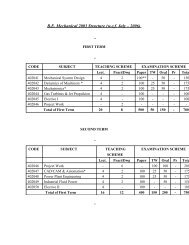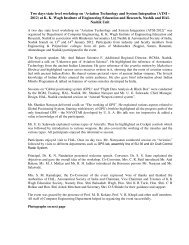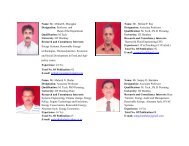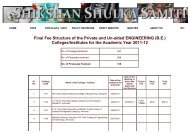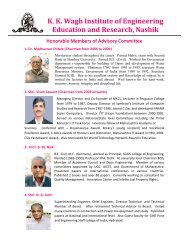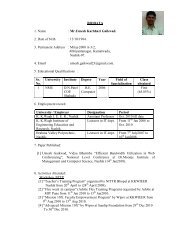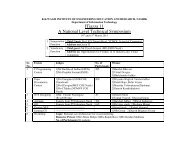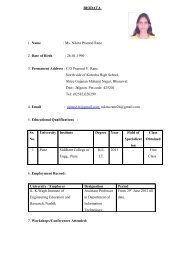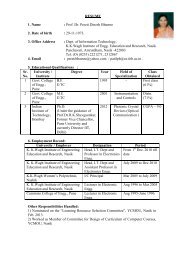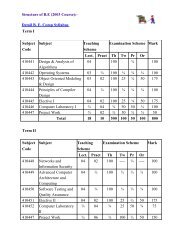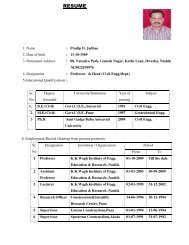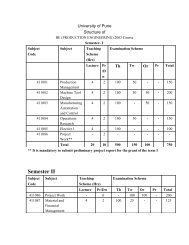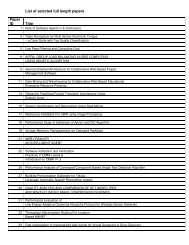MBA Semester III - K. K. Wagh Education Society
MBA Semester III - K. K. Wagh Education Society
MBA Semester III - K. K. Wagh Education Society
Create successful ePaper yourself
Turn your PDF publications into a flip-book with our unique Google optimized e-Paper software.
<strong>MBA</strong> <strong>Semester</strong> <strong>III</strong><br />
(301) BUSINESS POLICY & STRATEGIC MANAGEMENT<br />
1. Strategy and the Quest for Competitive Advantage: Military origins of strategy – Evolution<br />
- Concept and Characteristics of strategic management – Defining strategy – Mintzerbg’s 5Ps of<br />
strategy – Corporate, Business and Functional Levels of strategy - Strategic Management<br />
Process. (4)<br />
2. Strategic Intent & Strategy Formulation: Vision, mission and purpose – Business<br />
definition, objectives and goals – Stakeholders in business and their roles in strategic<br />
management - Corporate Social Responsibility, Ethical and Social Considerations in Strategy<br />
Development. (4)<br />
3. Strategic analysis: Analyzing Company’s Resources and Competitive Position -<br />
Organizational Capability Profile – Strategic Advantage Profile – Core Competence - Distinctive<br />
competitiveness. (4)<br />
4. Analyzing Company’s External Environment: Environmental appraisal – Scenario planning<br />
– Preparing an Environmental Threat and Opportunity Profile (ETOP) – Industry Analysis -<br />
Porter’s Five Forces Model of competition. (4)<br />
5. Corporate Portfolio Analysis: Business Portfolio Analysis - Synergy and Dysergy - BCG<br />
Matrix – GE 9 Cell Model - Concept of Stretch, Leverage and fit (3)<br />
6. Generic Competitive Strategies: Low cost, Differentiation, Focus. (3)<br />
7. Grand Strategies: Stability, Growth (Diversification Strategies, Vertical Integration<br />
Strategies, Mergers, Acquisition & Takeover Strategies, Strategic Alliances & Collaborative<br />
Partnerships), Retrenchment, Outsourcing Strategies. (8)<br />
8. Tailoring strategy to fit specific industry – Life Cycle Analysis - Emerging, Growing,<br />
Mature & Declining Industries. (4)<br />
9. New Business Models and strategies for Internet Economy: Shaping characteristics of E-<br />
Commerce environment – E-Commerce Business Model and Strategies – Internet Strategies for<br />
Traditional Business – Key success factors in E-Commerce – Virtual Value Chain. (6)<br />
10. Strategy implementation - Project implementation – Procedural implementation – Resource<br />
Allocation – Organization Structure – Matching structure and strategy. (3)<br />
11. Behavioural issues in implementation – Corporate culture – Mc Kinsey’s 7s Framework -<br />
Concepts of Learning Organization (3)
12. Functional issues – Functional plans and policies – Financial, Marketing, Operations,<br />
Personnel, IT. (2)<br />
13. Strategy Evaluation – Operations Control and Strategic Control - Symptoms of<br />
malfunctioning of strategy –– Balanced Scorecard. (2)<br />
14. Cases in strategic management: A minimum of 5 cases encompassing the above topics to<br />
be analyzed and discussed in the class. (10)<br />
Books Recommended:-<br />
1. A A Thompson Jr., A J Strickland <strong>III</strong>, J E Gamble, Crafting & Executing Strategy<br />
– The Quest for Competitive Advantage, Tata McGraw Hill, 4th ed., 2005.<br />
2. Ranjan Das, Crafting the Strategy: Concepts and Cases in Strategic Management,<br />
Tata McGraw Hill, 2004.<br />
3. Henry, Mintzberg, Bruce, Ahlstrand and Joseph, Lampel (1998). Strategy Safari. Free Press,<br />
New York.<br />
4. Gary, Hamel and Prahalad, C. K. (1999). Competing for the Future. HBS Press.<br />
5. Ed. C.A. Montgomery, M.E. Porter, Strategy – Seeking and Securing Competitive Advantage,<br />
Harvard Business Review Publications, 1991.<br />
6. Peter F. Drucker, Managing in a Time of Great Change, Truman Talley Books /<br />
Plume Penguin Group, 1998.
(302) MANAGEMENT CONTROL SYSTEMS<br />
1. Characteristics of Management Control System – Evolution of control systems in an<br />
organization –– Strategic Planning, Management Control and Operational Control - Cybernetic<br />
Paradigm of Grissinger (3)<br />
2. Understanding strategies – Concept of strategy – Business Unit level and corporate strategy<br />
- Gaining competitive advantage (3)<br />
3. Goals - Hierarchy of Goals – Goal congruence – factors that affect goal congruence –<br />
formal and informal systems – Types of organization structure in the perspective of Global<br />
scenario. - Functions of the Controller. (3)<br />
4. Responsibility Centers – Types of Responsibility Centers – Expense Centers, Profit Centers<br />
and Investment Centers – measures used to evaluate their performances –<br />
such as ROI, ROA, MVA, EVA – DuPont analysis (13)<br />
5. Budgetary Control as a control tool – Revision of budgets – ZBB – Budgetary control<br />
approach with respect to Engineered and Discretionary costs – Committed costs (6)<br />
6. Capital Budgeting as a tool for management performance measurement (6)<br />
7. Transfer Pricing – Objectives and need of Transfer pricing –Methods of Transfer pricing -<br />
Cost Based, Market price based, Two steps, Dual price, Profit sharing- Administration and<br />
Related numerical problems (8)<br />
8. Performance Evaluation through Balanced Scorecard – Four perspectives. (6)<br />
9. Management Control Systems in Service Sector vis-à-vis in Manufacturing Sector<br />
– Banking, Insurance, BPO. (6)<br />
10. Introduction to Audit Function as a control tool covering Financial Audit, Internal Audit,<br />
Cost Audit - Management Audit – Principles and Objectives (6)<br />
Books Recommended:-<br />
1. Management Control Systems, 10th Ed. – Anthony and Govindrajan<br />
2. Practical Auditing – B.N.Tandon<br />
3. Cost Accounting – B.K.Bhar<br />
4. Management Accounting – Khan & Jain<br />
5. Financial Management – Prasanna Chandra<br />
6. Guidance note on Transfer Pricing – ICAI Publication
(303A)- MARKETING RESEARCH<br />
1. Marketing Research – Definition, Scope, Significance, Limitations, Obstacles in acceptance.<br />
Ethics in marketing research. Marketing Intelligence system (2)<br />
2. Research process – Management dilemma (problem) – decision problem – research problem<br />
– hypothesis statement – characteristics of a good hypothesis – drafting the research proposal. (4)<br />
3. Various sources of market Information – Methods of collecting Market Information -<br />
Secondary data – sources – problems of fit and accuracy. Syndicated services. (2)<br />
4. Marketing research techniques:<br />
Market development research: Cool hunting – socio cultural trends, Demand Estimation<br />
research, Test marketing, Segmentation Research - Cluster analysis, Discriminant analysis. Sales<br />
forecasting – objective and subjective methods (8)<br />
5. Marketing Mix Research: Concept testing, Brand Equity Research, Brand name testing,<br />
Commercial eye tracking – package designs, Conjoint analysis, Multidimensional<br />
scaling - positioning research, Pricing Research, Shop and retail audits, Advertising Research –<br />
Copy Testing, Readership surveys and viewer ship surveys, Ad tracking, viral<br />
marketing research. (14) Marketing effectiveness and analytics research: Customer Satisfaction<br />
Measurement, mystery shopping, Market and Sales Analysis (2)<br />
6. Exploratory designs – Descriptive designs - Longitudinal and cross-sectional analysis (2)<br />
7. Qualitative research techniques – a) Based on questioning: Focus groups, Depth interviews,<br />
Projective techniques. b) Based on observations: ethnography, grounded theory, participant<br />
observation (4)<br />
8. Causal research – Basic experimental designs – internal and external validity of experiments.<br />
(2)<br />
9. Primary data – Questionnaire design - Administration and analysis considerations in design -<br />
Attitude measurement – scaling techniques. Observation method of primary data collection. Web<br />
based primary data collection – issues of reach, analysis, accuracy , time and efficiency. (4)<br />
10. Sampling – sampling methods – sampling and non sampling errors – sample size calculation<br />
(Numericals expected) – population and sample size - large and small samples - practical<br />
considerations in determining sample size. (4)<br />
11. Data analysis – Univariate analysis – Bivariate analysis – Multivariate analysis. Simple and<br />
cross tabulation, simple and multiple regression, Factor analysis. (6)
12. Hypothesis testing – Types of tests and test selection, One sample test, Two- Independent<br />
Sample tests, Two-related sample tests. Chi-square test, tests for large and small samples.<br />
(Numericals expected) (4)<br />
13. Report writing – forms of report – fundamentals of a good report. (2)<br />
Books Recommended:-<br />
1. Marketing Research, Concept & Cases – Cooper Schindler.<br />
2. Research for Marketing Decisions – Paul Green, Donald Tull, Gerald Albaurn<br />
3. Marketing Research – Nargundkar.<br />
4. Marketing Research – Beri<br />
5. Marketing Research – Measurement & Methods – Donald S.Tull, Del I.Hawkins<br />
6. Marketing Research –Aakar, Kumar, Day
(304A)- INTEGRATED MARKETING COMMUNICATIONS<br />
1. Concept and Process of Integrated Marketing Communications (IMC):<br />
Elements of IMC & Developing respective communication campaign (42)<br />
a) Advertising – Classification of advertising, types, advertising appropriation, advertising<br />
campaigns<br />
b) Sales Promotion – Different types of Sales Promotion, relationship between Sales promotion<br />
and advertising<br />
c) Publicity – Types of Publicity, relationship between advertising and publicity<br />
d) Personal Selling<br />
e) Direct marketing and direct response methods<br />
f) Event Management<br />
g) E-Commerce<br />
h) Corporate Communication<br />
I) Public Relations – Types of PR<br />
j) Media relations<br />
k) Community relations<br />
l) Industrial relations and<br />
m) Government relations<br />
n) Employee relations (House Journals / Newsletter)<br />
o) Crisis Management<br />
p) Trade Fairs and Exhibitions<br />
2. IMC Message Design: AIDA model Considerations for creative idea Visualization (4)<br />
3. Media Management - Media Process - Media Jargons - Media Buying - Strategies and<br />
execution (4)<br />
4. Suppliers in IMC: Hoarding Contractors/Printers etc., Ad. Agency – Departments of Ad.<br />
Agency, Client Servicing-client Agency relationship, account Planning (7)<br />
5. Ethics and social responsibility in IMC campaigns. (1)<br />
6. Evaluating Marketing Communication Programs (2)<br />
Books Recommended:-<br />
1. Integrated Marketing Communications - Kenneth Clown& Donald Bach<br />
2. Advertising and Promotions - Belch & Belch, Tata McGraw Hill
3. Advertising Management - Rajeev Batra, John G.Myers & David A Aaker-PHI<br />
4. Otto Kleepner’s advertising Procedure - PH<br />
5. International Edition - Contemporary Advertising Irwin/McGraw –Hill<br />
6. Integrated Marketing Communications - Duncon- TMH<br />
7. Foundations of Advertising Theory & Practice- S.A.Chunawalla &<br />
K.C.Sethia- Himalaya Publishing
(305A)- DISTRIBUTION AND RETAIL MANAGEMENT<br />
1) Marketing Channels: Definition & Importance, Functions of Marketing Channels –<br />
Intensive, Selective & Exclusive distribution strategies, Decisions in Channel Management (8)<br />
2) Wholesaling: Concept, Importance, Functions –Wholesaler Marketing Decisions – Trends in<br />
Wholesaling (4)<br />
3) Retailing: Concept, Importance, Functions - Indian Vs. Global Scenario (4)<br />
4) Retail formats: Store & Non Store Retailing –- Franchising- Unconventional channels (6)<br />
5) Retail Location: Factors affecting location decision – Site Selection – 36 Location based<br />
retail Strategies (4)<br />
6) Store Design: Interiors and Exteriors - Store layout – Types of layouts – Factors affecting<br />
store layout – Store image mix – Store Façade – The Internet Store. (4)<br />
7) Store Administration: Floor space management–Managing store inventories and display (4)<br />
8) Merchandising: Concept, Importance, Functions – Steps in merchandising planning –<br />
Category management: Definition and process – Introduction to Private label brands (6)<br />
9) Retail Communication Mix: Planning retail communication – Managing in-store promotions<br />
and events (4)<br />
10) Integrated Marketing Channels: Channels for Consumer goods, Industrial goods &<br />
Services – Horizontal, Vertical, Multichannel Marketing Systems (4)<br />
11) Introduction to Supply Chain Management: Concept – significance – components. (4)<br />
12) Channel Management: Channel selection - Channel Conflicts & its Resolution- Channel<br />
Performance Evaluation (4)<br />
13) Technology in distribution: Bar-coding – RFID – Electronic payment systems (4)<br />
Books Recommended:-<br />
1) Channel Management –Stern – El- Ansary<br />
2) Retailing Management – Swapna Pradhan<br />
3) Retail Management – Gibson Vedamani<br />
4) Physical Distribution & Logistics Management – Dr. Subhash Bhave<br />
5) Channel Management & Retail Management – Meenal Dhotre
(306A) CONSUMER & ORGANIZATIONAL BUYING BEHAVIOUR<br />
1. Consumer Behavior: Concept, diversity of consumer behavior, Characteristics of Indian<br />
Consumers. (2)<br />
2. Influences on the Consumer: Consumer needs, motives - positive and negative motivation -<br />
rational versus emotional motives. Consumer relevant reference groups - opinion leaders - family<br />
decisions making and consumption related roles - family life cycle - social class and consumer<br />
behaviour - influence of culture on consumer behaviour- cross cultural context. Diffusion of<br />
innovations: the diffusion process – the adoption process - consumer innovativeness and<br />
personality traits. (8)<br />
3. Consumer decision making: Models of consumer decision making - Engle- Kollatt-<br />
Blackwell model, Howard-Sheth Model, Bettman’s Model, HCB Model. Concept of<br />
involvement & extensive problem solving - limited problem solving – routinized responsive<br />
behavior. (5)<br />
4. Post purchase behavior: Consumer satisfaction concept & Models – Expectancy<br />
Disconfirmation, Desires Congruency Model, Equity Theory, Attribution Theory, Cognitive<br />
dissonance, Consumer delight, consumer complaint behaviour. (5)<br />
5. Consumerism: Evolution of consumer society. Definition of consumerism, buyers & seller’s<br />
rights, effects of consumerism. (2)<br />
6. Organizational Buying: Concept & comparison with Consumer buying, Economic<br />
Influence; Political Influence; Legal Influence; Supplier’s Influence; Technology Influence;<br />
Customer Influence; Government Influence; Labour Influence, Analyzing Buyers’ strengths &<br />
Negotiation Capabilities (4)<br />
7. Organizational Influences on Buying Behavior: Buying Roles; Market Response<br />
The Buy Grid Model; The Organizational Buying Decision Process; Buying Tasks; Interpersonal<br />
Influencing in Organizational Buying (4)<br />
Books Recommended:-<br />
1. Consumer Behavior – Leon Schiffman, Leslie Lazar Kanuk<br />
2. Consumer Behavior – Hawkins, Best, Coney<br />
3. Customer Behavior – A Managerial Perspective – Sheth, Mittal – Thomson,<br />
4. Conceptual Issues In Consumer Behavior Indian Context – S Ramesh Kumar –<br />
Pearson,
5. Consumer Market demographics in India – Edited by S.L.Rao<br />
6. Understanding Your Customer - R.Woodruff and S.F.Gardial<br />
7. Consumer behaviour - Louden, Delebeta<br />
8. Industrial Marketing – Hill, Alexander, Cross<br />
9. Industrial Marketing – Analysis, Planning and Control – Reeder, Brierty, Reeder<br />
10. Industrial Marketing – P K Ghosh
(307A) SALES MANAGEMENT & PERSONAL SELLING<br />
1. Introduction to Sales Management: Concept, Nature, Role of Sales Management in<br />
Marketing, Salesmanship, Specific Characteristics of a successful salesman, The Evolving Face<br />
of Personal Selling (4)<br />
2. Sales Forecasting: Concept of Forecasting, Sales Forecasting methods, Quantitative and<br />
Qualitative methods. (4)<br />
3. Sales Organization: Need for Sales Organizations, their structure, Sales Managers Functions<br />
and responsibilities, Planning for major customers and sales Budget. (4)<br />
4. Personal Selling Process and Approaches: Personal Selling and Relationship Management -<br />
Selling to individuals & Institutions, Basics, Sales leads, Planning sales calls - Types of calls, –<br />
Building long term partnership by selling – Sales presentations, tools for personal selling, Sales<br />
Aids – Use of technology in sales effective selling techniques, Tele Marketing. (8)<br />
5. Managing the Sales Force:<br />
a) Recruiting, Selection and Training of Sales force: Procedures and criteria extensively used<br />
as selection tools for recruiting and testing sales ability. Sales Force Job Analysis and<br />
Description<br />
b) Areas of sales Training: Company Specific Knowledge, product knowledge Industry and<br />
Market Trend Knowledge, customers and technology – Relationship Selling Process and<br />
Customer education. Value added selling<br />
c) Motivating the Sales Team: Motivation Programs - Sales Meetings, Sales Contests, Sales<br />
Compensating, (Monetary compensation, incentive programs as motivators, Non -Monetary<br />
compensation – fine tuning of compensation package. Supervising,<br />
d) Evaluating Sales Force Performance and Controlling Sales activities:<br />
Sales Records and Reporting Systems, Improving Sales Productivity, Ethical and Legal Issues in<br />
Sales Management. (10)<br />
Books Recommended:-<br />
1. Sales Management - Richard Rstill, Edward W. Cundiff<br />
2. Strategies for selling-Gerald A.Michaelson<br />
3. Sales Management Handbook – Forsyth Patrick<br />
4. Value added selling-Tom Reilly<br />
5. Building a Winning Sales Team – Gini Graham & Scott
6. Professional Sales Management – Anderson, Hair and Bush<br />
7. Motivation and Job Satisfaction – M. D. Pestonjee<br />
8. Sales Management – Thomas<br />
9. International Marketing – Robert Reed……..<br />
10. Industrial Marketing – Hichard M. Hill
(303B)-ADVANCED FINANCIAL MANAGEMENT<br />
1. Accounting Standards: (6)<br />
1.1 Role of Accounting Standard board.<br />
1.2 Introduction to International Accounting Standards.<br />
1.3 Disclosure of Accounting Policies-Inventory, Depreciation,<br />
Investment, Fixed Assets, Amalgamation, EPS.<br />
2. Capital Structure Theories: (6)<br />
2.1 Net income approach.<br />
2.2 Net operating income approach.<br />
2.3 Modiglliani and Miller theory (MM approach).<br />
3. Dividend Distribution Theories: (9)<br />
3.1 Type of dividend<br />
3.2 Important consideration in dividend policy.<br />
3.3 Theories of dividend<br />
-Gordon growth model<br />
-Walters valuation model<br />
-MM-Irrelevance theory<br />
4. Working Capital Management: (9)<br />
4.1 Overtrading<br />
4.2 Symptoms of poor W. C. management<br />
4.3 W.C. management Strategies<br />
4.4 Tandon committee /Chore Committee Recommendations<br />
4.5 Latest trend in W.C. finance<br />
4.6 R.B.I guidelines on W.C. finance<br />
5. Capital Budgeting: (12)<br />
5.1 IRR and NPV method comparative study<br />
5.2 Capital rationing<br />
5.3 Capital budgeting during inflation<br />
5.4 Techniques of decision making under risk and uncertainty- Profitability and expected values,<br />
standard deviation, value of information, Optimistic pessimistic estimates, risk adjusted
discounted rate, certainty equivalent approach, simulation decision tree, sensitivity analysis,<br />
capital asset pricing model.<br />
6. Economic Value Added (EVA) (6)<br />
6.1 Concept of EVA<br />
6.2 Calculating EVA<br />
6.3 Adjustments for calculation of EVA<br />
6.4 Superiority of EVA<br />
7. Financial Analysis: (12)<br />
Using tools such as Cash Flow and Fund Flow<br />
Books Recommended:-<br />
1. Financial Management- I. M. Pandey<br />
2. Financial Management- Prassana Chandra<br />
3. Financial Management- Van Horne<br />
4. Financial Management- R.P. Rustagi<br />
5. Financial Management- Ravi M. Kishore.
(304B)- DIRECT TAXATION<br />
1. Accessibility Criteria (6)<br />
Definitions, Basic concept, person, Assessment year; previous year, assesses, Residential status;<br />
Incidence of tax, income exempt from tax.<br />
2. Computation of Income Under Various Heads<br />
a. Income under head salary: Meaning of salary, Basis of charge of salary income, different<br />
forms of salary, different forms of allowances, perquisites, permissible deductions from salary<br />
income, tax treatment of provident fund & approved superannuation fund, special tax treatment<br />
of salary income of non resident technicians, deduction under section-80C, FBT. (6)<br />
b. Income from house property: Basis of charge, property income not charge to tax, basis of<br />
computing income from let out house property, computing income from self occupied property.<br />
(5)<br />
c. Profits and gains of business or profession: chargeable incomes; expenses expressly allowed<br />
as deduction; general deductions; expenses specifically disallowed; compulsory maintenance of<br />
accounts, compulsory audit, assessment in special cases, (retail, transport, exploration of mineral<br />
oil) Computation of taxable income as profit and gain from business or profession. (6)<br />
d. Capital gains: Meaning of capital asset, valuation of capital asset; transfer, considered to be<br />
transfer, chargeability; computation of capital gain: short term and long term; computation of tax<br />
on capital gains. Exemption from capital gains. (5)<br />
e. Income from other sources: basis of charge; chargeable incomes; specific deductions;<br />
amount not deductible; computation of taxable income from other sources. (5)<br />
f. Computation of net taxable income: computation of total income, carry forward and set-off<br />
of losses and deductions under sec 80 and net taxable income and tax thereof. Cases of Indian as<br />
well as foreign companies, provision of minimum alternate tax and declaration and payment of<br />
dividend, Tax provision in case of mergers, acquisition or amalgamation of company. (7)<br />
3. Income –tax Payment and Assessment (5)<br />
Tax deduction at source; advance tax; self-assessment tax; assessment procedure regular and best<br />
judgment assess revision, rectification and appeal, provision relating to interest and refund of tax.<br />
4. Tax Planning (8)
Tax planning in capital budgeting decision, leasing, hire purchase or buy decision raising of<br />
capital: equity, debt or preference share, transfer pricing and its impact.<br />
5. Companies (7)<br />
Computation of taxable income, residential status of company, taxable income and tax liability,<br />
tax on income received from venture capital companies and venture capital funds<br />
Books Recommended:-<br />
1. Direct Taxes – Law and Practice – Vinod Singhnia<br />
2. Direct Taxes – Ravi Kishore<br />
3. Direct Taxes – J. P. Jakhotiya<br />
4. Direct Taxes- Ahuja<br />
5. Bare Acts and rules of the relevant taxes
(305B) - ADVANCE FINANCIAL SERVICES<br />
1. Overview of Indian Financial System- (9)<br />
Development Since 1991- Role of Financial Intermediaries- Various Financial Intermediaries<br />
2. Capital Market- (15)<br />
Instruments-Traditional and Emerging (ECB, ADR, GDR) Capital Marketing in India -<br />
Operations in Primary Markets-Instruments involved-Role of SEBI.<br />
3. Secondary Markets- (12)<br />
Stocks Exchanges in India-National Stock Exchange(NSE)—Stock Holding Corporation<br />
of India (SHCIL)-Share Trading- Introduction to Derivatives and Commodities-Scrip less<br />
Trading –E-Trading-Index/Futures Trading –Share Lending Scheme-Book Building – Buy back<br />
of shares-Mergers & Acquisition –Regulations.<br />
4. Money Market – (6)<br />
Nature and role of Money market in India – Instruments in Money Market viz, CPs, CDs,<br />
Bill of exchange, ICDs, Treasury Bill – Role of DFHI/STCI in Money Market – ECBs<br />
5. Financial Services – (6)<br />
Credit rating – Factoring and forfeiting – leasing and hire purchasing- Securitization of debts-<br />
Housing finance – Merchant Banking services and functions, Mutual Funds.<br />
6. All SEBI guidelines related to topics covered above (6)<br />
7. Current development are expected to be covered, International operations in stock<br />
market. (6)<br />
Books Recommended:-<br />
1. Indian Financial Services- M.Y. Khan<br />
2. Marketing of Financial Services- V. A. Avdhani<br />
3. Advance Financial Management- Kohak<br />
4. Relevant Text of SEBI Guidelines.
306B-BANKING & FINANCIAL INSTITUTIONS<br />
1. Developments since 1991-Recent Trends-Role of Financial Intermediaries in a financial<br />
system-Various financial intermediaries -Introduction to banking system -Types of bank –<br />
Instruments -Terms like NPAs (9)<br />
2. Study of various interest rates-<br />
Short Term-Emergence of Repose rate as the benchmarks rate in the short term-Floating and<br />
fixed rates of interest-LIBOR, MIBOR and MIBID (9)<br />
3. RBI-Role played by them-Salient features of status governed by them- Monetary Policy,<br />
Fiscal Policy, Union (Government) Budget and its Implications (9)<br />
4. Commercial Banking-Management of assets and liabilities- Effect of RBI policies on the<br />
operations commercial banks-Recent reforms in Banking sector-Recovery of debts- Calculation<br />
of EMIs Emerging trends in banking like e banking, mobile banking, credit banking (15)<br />
5. Non-Banking Financial Companies- Functions of NBFCs Types and RBI Guidelines(6)<br />
6. Pricing of products and services in financial service sector. (12)<br />
Books Recommended:-<br />
1. Financial Institutions & Markets- L.M. Bhole<br />
2. Indian Financial System- M.Y.Khan<br />
3. Indian Financial System- H.R. Machiraju
(307B)- SECURITY ANALYSIS & PORTFOLIO MANAGEMENT<br />
1. Investment Scenario. (1)<br />
2. Risk and Return-Alpha & Beta. (1)<br />
3. Security Market Indicators. (2)<br />
4. Fundamental Analysis. (3)<br />
5. Equity stock valuation models. (3)<br />
6. Bond valuation. (3)<br />
7. Efficient market hypothesis. (3)<br />
8. Technical Analysis. (4)<br />
9. Emerging trend of Security Analysis in global market. (2)<br />
10. Portfolio analysis and portfolio selection. (4)<br />
11. Personal Financial Management. (4)<br />
Books Recommended:-<br />
1. Portfolio Management- Kevin<br />
2. Portfolio Management- Prasanna Chandra<br />
3. Portfolio Management- Barua<br />
4. Stock Exchanges and Investments- Raghunathan<br />
5. Security Analysis and Portfolio Management- Fisher and Jordon<br />
6. Portfolio Management – V. K. Bhalla
(303C) SOFTWARE ENGINEERING<br />
1 System Concept<br />
Definitions, Integrated Systems, Sub-systems, Modules (4)<br />
2 Role of Software Engineer / Analysts / Users in the various phases of Systems Development<br />
Life Cycle (2)<br />
3 General phases of Systems Development Life Cycle<br />
Feasibility Study, Requirements Capture, Detailed Systems Analysis, Systems Design, Testing,<br />
On-site Implementation and Maintenance (12)<br />
4 Fact Finding Methods (2)<br />
5 Different Approaches to Software Development<br />
Waterfall Model, Spiral Model, Prototyping, RAD, Object Oriented, 4GL (10)<br />
6 Structured Analysis and Design Method and Software Engineering (20)<br />
Techniques<br />
Tools and Methodologies in Systems Development<br />
Application Systems Modeling;<br />
Process Modeling - Data Flow Diagrams; Concept of Object Oriented Modeling Temporal<br />
Modeling - State Transition Diagrams; Database Design Methods<br />
Data Modeling - Entity Relationship Method; Mapping E-R Model to arrive at the Database<br />
Design; Normalization Technique for Database Design; Controlled De-normalization<br />
System Documentation Techniques- System Flow Charts; Functional Decomposition<br />
Diagrams; Structure Charts; Structured Flow Charts (N-S Diagrams)<br />
Logic Representation Techniques<br />
Decision Trees; Decision Tables; Pseudo code and Structured English<br />
7 Users Interface Design<br />
Menu, Screen and Report Layout Designing<br />
The Mode/Style of interaction between the system and the user (4)<br />
8 Codes Designing for field values - Designing Code-less system (2)<br />
9 Introduction to Computer Aided Software Engineering (CASE) (2)<br />
10 Types of Data Processing - Batch, On-line and Real Time Processing (2)
Books Recommended:-<br />
1. Analysis and Design of Information System 2nd Ed. - Senn<br />
2. Software Engineering Practitioner's Approach - Roger Pressman<br />
3. Introduction to Systems Analysis and Design - Hawryszkiwycz<br />
4. Systems Analysis and Design - Elias Awad<br />
5. Introducing Systems Analysis and Design - Lee<br />
6. Systems Analysis and Design - Perry Edwards<br />
7. Software Engineering Concepts – Fairley
(304C) RELATIONAL DATABASE MANAGEMENT SYSTEMS<br />
1. Introduction<br />
1.1 History: Advantages and limitations of RDBMS; Users of RDBMS<br />
1.2 Software Modules in RDBMS; Architecture of RDBMS. (4)<br />
2. Modeling Techniques<br />
2.1 Different Types of Models, Introduction to ERD. (6)<br />
3. Hierarchical Database (2)<br />
4. Network Database (2)<br />
5. Relational Database<br />
Introduction; Codd's Rules; Concept of Domain, Tuple,<br />
Cardinality; Comparison between HDB-NDB-RDB (6)<br />
6. Normalization<br />
Advantages and disadvantages of Normalization; 1NF-2NF-3NF- rules with examples<br />
Anomalies. (10)<br />
7. SQL commands.<br />
Basic Structure, Set Operations, Aggregate Functions, Null Values, Nested Sub queries, Views,<br />
Complex Queries, Modification of the Database, Joined Relations, Data-Definition Language,<br />
Embedded SQL, Dynamic SQL, Exercises. (20)<br />
8. Introduction to object oriented database<br />
Concept, Object binding in Oracle - Class, Attribute, Methods, Object type, Definition,<br />
Declaring and initializing, Methods, Alter and Drop type. (10)<br />
Books Recommended:-<br />
1. DATABASE System Concepts, Silberschatz , Korth, Sudarshan<br />
2. SQL by Scott Urman
(305C) VISUAL BASIC AND ORACLE<br />
1. Introduction to Visual Basic<br />
Event-driven Programming, Starting and Exiting VB, Understand VB Environment, Project<br />
Explorer, Properties Window, Toolbox, Form Layout Window, Property Pages, Getting Help,<br />
Saving Project, Printing Project, Running Applications. (3)<br />
2. Adding Code and Events<br />
Code Window, Naming Conventions, Variables (all data types) - Byte, Boolean, Integer, Long<br />
(long integer), Single (single-precision floating point), Double (double precision floating point),<br />
Currency (scaled integer), Decimal, Date, Object, String (variable length), String (fixed -length),<br />
Variant (with numbers), Variant (with characters), User defined (using type), Scope (Globa l,<br />
Local, Static), Constants. (3)<br />
3. Visual Basic Controls<br />
Label and Textbox Controls, Command Button Controls, Frame, Checkbox and Option Button<br />
Controls, List Box and Combo Box Controls, Drive List Box, Directory List Box and File List<br />
Box Controls, Formatting Controls, Control Arrays, Tab Order. (5)<br />
4. Working with functions<br />
String Functions, Mathematical Functions, Date Functions, Data type Conversion Functions. (3)<br />
5. Control Statement<br />
IF and IIF Statement, Select Case Statement, Do Statement, For Statement Exit Statement. (2)<br />
6. Dialog Boxes<br />
Msgbox, Inputbox, Common Dialog Box (Microsoft Common Dialog Control 6.0) (2)<br />
7. Menus<br />
Creating Menus, Adding Code to Menus, Toolbars, Other Common Controls (Microsoft<br />
Windows Common Controls 6.0, Microsoft Windows Common Controls- 3 6.0) (3)<br />
8. Accessing data<br />
Reading and Writing Files, Data Form Wizard, Data Control, Data Grid Control, DBCombo Box<br />
and DB-List Box, SQL Queries in VB, Jet DAO ADO (with controls and code), Error Handling.<br />
(5)<br />
9. Objects and Classes (Only Basic Definition)<br />
OLE Control, Programming with objects (Creating objects of a user defined class and using them<br />
on the form). (2)
10. Windows API<br />
Defining Windows API, DLLs, Declare Statement, Calling API routine (1)<br />
11. Crystal Reports (8.5) – Overview (1)<br />
ORACLE<br />
1. Introduction to Oracle Architecture (1)<br />
2. Queries<br />
a. Select with all options, Operators, Arithmetic, Comparison,<br />
b. Logical ( in, between, like, all, %, _, any, exists, is null, and ,or, not, Distinct)<br />
c. Order by clause (2)<br />
3. SQL Functions<br />
a. Date: Sys_date , next_day, Add_months, last_day, months_between,<br />
b. Numeric: Round, trunc, abs, ceil, cos, exp, floor<br />
c. Character: Initcap, lower, upper, ltrim, rtrim, translate, length, lpad, rpad, replace<br />
d. Conversion: to_char, to_date, to_number<br />
e. Miscellaneous: Uid, User, nvl, vsize, decode, rownum<br />
f. Group function: avg, max, min, sum, count, with Group by and Having Clause<br />
g. Nested functions (7)<br />
4. Joins :Simple join, Equi join, Non equi join, Self join, Outer join, Set operators (Union, union<br />
all, intersect, minus), Sub queries and Correlated query, DML statements (Insert, Update, Delete<br />
with where clause), TCL (Commit, Rollback, Savepoint), Locks in Oracle, DDL Statements (4)<br />
5. Data types<br />
Character, Char, Varchar/varchar2, Long Number, Number (p) - fixed point, Number (p, s) -<br />
floating point, Date, Raw, Long raw, Introduction to LOB datatypes (CLOB, BLOB, BFILE) (4)<br />
6. Table<br />
Create, Alter, Drop, Truncate, Rename Constraints ( Primary key, Foreign Key, Unique Key,<br />
Check, Default, Not Null, On delete, Cascade) Column level and Table level constraints Oracle<br />
Objects Views, Sequences, Synonyms, Index (Define, Alter and Drop) (4)<br />
7. Introduction to Report writing using SQL<br />
(Title, Btitle, skip, set, pause, column, sql.pno, Break on, compute sum, set server<br />
output on.) (2)
8. Database Triggers<br />
Types of Triggers, Enabling, disabling, Predicates- inserting, updating, deleting (3)<br />
9. Procedures and Functions<br />
Definition, Implementation and Execution (3)<br />
Books Recommended:-<br />
1. Visual Basic 6.0 Programming - Holzner Steven<br />
2. Visual Basic 6.0 in 21 days - Perpy Greg<br />
3. Peter Norton's Guide to Visual Basic 6.0 - Peter Norton<br />
4. Visual Basic 6.0 - Peter Wright<br />
5. Visual Basic 6.0 – Corhell<br />
6. Oracle8- William G Page Jr. and Nathan Hughes
(306C) ENTERPRISE RESOURCE PLANNING (ERP)<br />
1 Enterprise Resource Planning –Introduction<br />
What is ERP?, Need of ERP, Advantages of ERP, Growth of ERP (4)<br />
2 ERP and Related Technologies<br />
Business process Reengineering (BPR)<br />
Management Information System (MIS)<br />
Decision Support Systems (DSS)<br />
Executive Support Systems (ESS)<br />
Data Warehousing, Data Mining<br />
Online Analytical Processing (OLTP)<br />
Supply Chain Management (SCM)<br />
Customer Relationship Management (CRM) (12)<br />
3 ERP modules & Vendors<br />
Finance<br />
Production planning, control & maintenance<br />
Sales & Distribution<br />
Human Resource Management (HRM)<br />
Inventory Control System<br />
Quality Management<br />
ERP Market (8)<br />
4 ERP Implementation Life Cycles<br />
Evaluation and selection of ERP package<br />
Project planning<br />
Implementation team training & testing<br />
End user training & Going Live<br />
Post Evaluation & Maintenance (3)<br />
5 ERP Case Studies<br />
Post implementation review of ERP Packages in Manufacturing, Services, and other<br />
Organizations (3)<br />
Books Recommended:-<br />
Enterprise Resource Planning - Alexis Leon
ERP Ware: ERP Implementation Framework –<br />
V.K. Garg & N.K. Venkitakrishnan<br />
ERP: By Leon, ERP Concepts and Planning - Garg & Venkitakrishnan<br />
(307C)- C PROGRAMMING<br />
1 An Overview of C (2)<br />
1.1. A Brief History of C<br />
1.2. C is middle-level Language<br />
1.3. C is a Structured Language<br />
1.4. Complier Vs Interpreters<br />
1.5. The Form of a C Program.<br />
1.6. Library & Linking.<br />
1.7 Compilation & Execution of C. Program on Dos & Unix<br />
2. Variables, Data Types, Operator & Expression (6)<br />
2.1. Character Set<br />
2.2. C Token<br />
2.3. Identifier & Keyword<br />
2.4. Constant<br />
2.4.1 Integer Constant<br />
2.4.2 Floating Point Constant<br />
2.4.3. Character Constant<br />
2.4.4. String Literals<br />
2.4.5. Enumeration Constant<br />
2.5. Data Types in C<br />
2.6. Data Declaration & Definition<br />
2.7. Operator & Expression<br />
2.7.1. Arithmetic Operator<br />
2.7.2. Relational Operator<br />
2.7.3. Logical Operator<br />
2.7.4. Increment & Decrement Operator<br />
2.7.5. Bitwise Operator
2.7.6. Assignment Operator<br />
2.7.7. Conditional Operator<br />
2.7.8. Precedence & Associatively of Operators.<br />
3. Console I/O (2)<br />
3.1. Introduction<br />
3.2. Character input & Output.<br />
3.3. String Input & Output.<br />
3.4. Formatted Input/Output (scanf/printf)<br />
3.5. sprintf & sscanf<br />
4. Control Statement (4)<br />
4.1. Introduction<br />
4.2. Selection Statements<br />
4.2.1. if<br />
4.2.2. Nested if<br />
4.2.3. The if-else-if<br />
4.2.4. The? alternative<br />
4.2.5. The Conditional Expression<br />
4.2.6. switch<br />
4.2.7. Nested switch<br />
4.3. Iteration Statements<br />
4.3.1. The for loop<br />
4.3.2. The while loop<br />
4.3.3. The do-while loop<br />
4.4. Jump Statements<br />
4.4.1. The goto & label<br />
4.4.2. The break & continue<br />
4.4.3. The exit () function<br />
5. Pointers (4)<br />
5.1 Introduction<br />
5.2 Memory Organization<br />
5.3 The basics of Pointer
5.4 The Pointer operator<br />
5.5 Application of Pointer<br />
5.6. Pointer Expression<br />
5.6.1. Declaration of Pointer<br />
5.6.2. Initializing Pointer<br />
5.6.3. De-referencing Pointer<br />
5.7. Pointer Arithmetic<br />
5.8. Precedence of &, * operators<br />
5.9. Pointer to Pointer<br />
6. Array & String (3)<br />
6.1. Single Dimension Arrays<br />
6.1.1. Accessing array elements<br />
6.1.2. Initializing an array<br />
6.2. Multidimensional Arrays<br />
6.2.1. Initializing the arrays<br />
6.2.2. Memory Representation<br />
6.2.3. Accessing array elements<br />
6.3. Passing Single Dimension array to Function<br />
6.4. Array & Pointer<br />
6.5. Array of Pointer<br />
6.6. String Manipulation Functions<br />
7. Function (2)<br />
7.1. Introduction<br />
7.2. Arguments & local variables<br />
7.3. Returning Function Results<br />
7.4. Call by reference & Call by value<br />
7.5. Recursion<br />
8 Structure, Union, Enumeration & type def (4)<br />
8.1. Structures<br />
8.1.1. Declaration and Initializing Structure<br />
8.1.2. Accessing Structure members
8.1.3. Structure Assignments<br />
8.1.4. Arrays of Structure<br />
8.1.5. Passing Structure to function<br />
8.1.6. Structure Pointer<br />
9 Unions (1)<br />
10 File handling (2)<br />
10.1. Introduction<br />
10.2. Defining & Opening a File<br />
10.3. Closing a File<br />
10.4. Input/Output Operations on Files<br />
Books Recommended:-<br />
1. C: The Complete Reference: Herbert Schildt<br />
2. Let us C Solutions: Y.P. Kanetkar<br />
3. Spirit Of “C”: Moolish Kooper.<br />
4. Programming in C: S. Kochan.<br />
5. C Programming Language: Kernighan & Ritchie.<br />
6. Programming in C: R. Hutchison.<br />
7. Graphics Under C: Y. Kanetkar
(303D)- INVENTORY MANAGEMENT & MATERIAL REQUIREMENTS<br />
PLANNING<br />
1. Inventory Management: Inventory concept; need for inventory; types of inventory,<br />
functions, use; Dependent and Independent Demand, Responsibility for inventory management.<br />
(6)<br />
2. Strategic Inventory Management: Objectives and Importance of the inventory management<br />
function in reference to Profitability, Strategy, customer satisfaction and Competitive Advantage.<br />
(2)<br />
3. Inventory Control Techniques: Inventory classification and its use in controlling inventory,<br />
Setup time and inventory control, safety stock determination considering service level. Strategies<br />
to increase Inventory Turns, Reduce throughput time, Reduce WIP, eliminate waste, and reduce<br />
inventory level in service and manufacturing organizations. (10)<br />
4. Inventory Models: Inventory models – Fixed Order Versus Fixed Interval systems –<br />
Developing Special Quantity Discount Models – Inventory Model for Manufactured Items –<br />
Economic Lot Size when Stock Replenishment is instantaneous – Non-instantaneous<br />
Replenishment Models – Inventory Models with uncertainty – Probabilistic Inventory Models –<br />
Models with Service Levels and Safety Stock. (12)<br />
5. Material Requirement Planning Systems (MRP): Meaning, purpose and advantage of<br />
MRP, Data Requirements and Management – Files and Database – Updating Inventory Records<br />
– Bill of Materials, types of BOM, Modular BOM, Master Production Schedules - meaning,<br />
objectives process. Managing MPS inventory records, lot sizing, process of MRP, and output of<br />
MRP. Introduction to MRPII systems. Using Distribution Resource Planning to manage<br />
inventories in multiple locations. (12)<br />
6. Make Or Buy Decisions: Concept of outsourcing, Factors influencing Make Or Buy<br />
Decisions, Trends in Make Or Buy Decisions in context of core competency. (4)<br />
7. Materials Management In Jit Environment: Zero inventory concept, Excess Inventory: A<br />
Roadblock to World-Class Manufacturing, Materials management in JIT environment, Vendor<br />
Managed Inventory, vendor relationship in JIT context. (9)<br />
8. Performance: Evaluation of Performance Of Materials Function - Criteria and methodology<br />
of evaluation. (5)<br />
Books Recommended:-
1. Foundations of Inventory Management – Zipkin, McGraw Hill.<br />
2. Orliky’s MRP – Plossl<br />
3. Production Planning And Inventory Control - Seetharama L Narsimhan, Dennis<br />
W McLeavy, Peter J Billington, Prentice Hall Of India Pvt Ltd,<br />
4. Introduction To Materials Management, - J. R. Tony Arnold, Stephen N.<br />
Chapman - Prentice Hall<br />
5. Principles of Inventory and Materials Management - Richard J. Tersine, Prentice<br />
Hall PTR<br />
6. Essentials of Inventory Management - Max Muller, AMACOM/American<br />
Management Association<br />
7. Production And Inventory Control - J H Greene, Homewood <strong>III</strong>: Richard D Irwin<br />
8. Materials Management – A.R.Palit
(304D)- MODELING TECHNIQUES AND IT FOR OPERATIONS<br />
MANAGEMENT<br />
1. INTRODUCTION TO BUSINESS MODELING: Modeling – meaning and process,<br />
Certainty and uncertainty in models, importance of understanding data before modeling,<br />
modeling with spreadsheet in simple decision situations. (6)<br />
2. LINEAR PROGRAMMING: Application of LPP in operations management, Formulation of<br />
LPP, simplex method, duality, Sensitivity Analysis. Trans-shipment problems. Concept of Goal<br />
programming, Goal programming model formulation. (Numericals Expected) (12)<br />
3. DECISION TREES: Concept, Application of Decision Trees in operations management.<br />
(Numericals Expected) (6)<br />
4. SEQUENCING PROBLEMS: Concept, Application, n jobs – 2 machines, n jobs - 3<br />
machines, n jobs – m machines. Comparison of priority sequencing rules. (Numericals Expected)<br />
(10)<br />
5. DYNAMIC PROGRAMMING: Conceptual Introduction to Dynamic programming. (3)<br />
6. SIMULATION: Concept, Applications in Operations management. (3)<br />
7. DESIGN OF EXPERIMENTS: Concept and Introduction. (3)<br />
8. IT IN OPERATIONS: Importance of IT in operations, IT as a competitive edge, Role of IT<br />
in – Design, Production Planning, Layout and Logistical operations. (4)<br />
9. SOFTWARES IN OPERATIONS: Introduction, characteristics and key features of<br />
software’s for Project Scheduling, Logistics / Supply chain management and Quality<br />
management. (5)<br />
10. INTRODUCTION TO ERP SYSTEMS: Review of DBMS and Transaction processing<br />
concepts - Business Processes and integration across functions Salient features of ERP systems<br />
offered by leading vendors, prerequisites and process of implementation. (8)<br />
Books Recommended:-<br />
1. Quantitative Techniques in Management- N.D. Vohra – Tata- Mcgraw-Hill<br />
Publications<br />
2. Quantitative Techniques for Managerial Decisions – J.K.Sharma – Macmillan India<br />
Ltd.<br />
3. Managerial Decisions Modeling with Spreadsheets – Bal Krishnan, Render, Stair, Jr.<br />
- Pearson <strong>Education</strong>.
4. Operations Management for Competitive Advantage – Chase, Aquilano, Jacobs,<br />
Agarwal – Tata McGraw- Hill Publications<br />
5. Production and Operations Management – Chary - Tata McGraw- Hill Publications<br />
6. Introduction to Operations Research – Gillette B.E. – A computer oriented Approach –<br />
Tata McGraw Hill Publications<br />
7. Operations Research – Taha Hatndy, A – An Introduction- PHI New Delhi<br />
8. Quantitative Analysis for Management – Render, Stair, Jr. – Pearson <strong>Education</strong>.<br />
9. Optimization Methods in Operations Research and Systems Analysis – Mittal and<br />
Mohan - New Age International Publishers, New Delhi<br />
10. ERP Demystified- Eilon.
(305D)- SUPPLY CHAIN & LOGISTICS MANAGEMENT<br />
1. TWENTY FIRST CENTURY SUPPLY CHAINS: The Supply Chain Revolution –<br />
Generalized Supply Chain Model – Supply chain and networks – Extended organization -<br />
Integrative Management – Responsiveness – Financial Sophistication – Globalization- Digital<br />
Business Transformation (4)<br />
2. LOGISTICS: The Logistics Of Business - The Logistical Value Proposition- The Work Of<br />
Logistics-Logistical Operating Arrangements - Flexible Structure – Supply Chain<br />
Synchronization. (2)<br />
3. CUSTOMER ACCOMMODATION: Customer Focused Marketing – Customer Services-<br />
Customer Satisfaction -Customer Success-Forecasting. (2)<br />
4. PROCUREMENT AND MANUFACTURING: The Quality Imperative- Procurement –<br />
Manufacturing-Logistical Interfaces. (2)<br />
5. INFORMATION TECHNOLOGY FRAMEWORK: Information System Functionality-<br />
Comprehensive Information System Integration-Communication Technology-Rationale For ERP<br />
Implementation-ERP System Design-Supply Chain Information System Design. (8)<br />
6. INVENTORY: Inventory Functionality and Definitions-Inventory Carrying Cost-Planning<br />
Inventory-Managing Uncertainty-Inventory Management Policies- Inventory Management<br />
Practices. (6)<br />
7. TRANSPORTATION: Transport Functionality, Principles and Participants- Transportation<br />
Service - Transportation Economic And Pricing- Transport Administration –Documentation. (6)<br />
8. WAREHOUSING: Strategic Warehousing-Warehousing Operations- Warehousing<br />
Ownership Arrangements- Warehouse Decisions. (4)<br />
9. PACKAGING AND MATERIALS HANDLING: Packaging Perspectives- Packaging For<br />
Materials Handling Efficiency-Materials Handling. (6)<br />
10. OPERATIONAL INTEGRATION: Why Integration Creates Value- Systems Concept And<br />
Analysis-Logistical Integration Objectives-Enterprise Integration- Supply Chain Processes-Sales<br />
And Operations Planning(S & OP)-Supply Chain Planning Considerations-Pricing. (6)<br />
11. GLOBAL STRATEGIC POSITIONING: Global Supply Chain Integration- Supply Chain<br />
Security-International Sourcing. (4)<br />
12. NETWORK INTEGRATION: Enterprise Facility Network- Warehouse<br />
Requirements-Total Cost Integration-Formulating Logistical Strategy. (4)
13. RELATIONSHIP DEVELOPMENT AND MANAGEMENT: Development And<br />
Management Of Internal Logistics Relationships-Development And Management Of Supply<br />
Chain Relationships. (4)<br />
14. E COMMERCE AND SCM: E commerce advantages and disadvantages for SCM – e-<br />
commerce as an enabler – evolution of world class supply chains – EDI – Exchanges, hubs and<br />
marketplaces – ERP(2)<br />
Books Recommended:-<br />
1. Supply Chain Logistics Management - Bowersox, Closs & Cooper – McGraw-Hill, 2nd Indian<br />
ed.<br />
2. World Class Supply Management - Burt, Dobbler, Starling, TMGH, 7th ed.<br />
3. Global operations & Logistics- Philippe - Pierre Dornier, John Wiley & sons Inc, New York,<br />
2002.<br />
4. Designing and Managing the supply chain - David Simchi, Levi & Philip Kaminski, McGraw-<br />
Hill Companies Inc., 2000.<br />
5. Operations Now – Finch, Mc Graw Hill, 3rd ed.
(306 D)- WORLD CLASS MANUFACTURING<br />
1. Historical perspective: World class Excellent organizations – American and Japanese<br />
Companies Deming Awards , Malcom Baldrige National Quality Award – Globalization –<br />
Global Companies – Models for manufacturing excellence – Business Excellence. (6)<br />
2. Bench marks, Bottlenecks and Best Practices: Concepts of benchmarking, bottleneck and<br />
best practices, Best performers – Gaining competitive edge through world class manufacturing –<br />
Value added manufacturing – eliminating waste – Toyota Production System – example. (6)<br />
3. System & tools for world class manufacturing: Improving Product & Process Design –<br />
Lean Production – SQC , FMS, Rapid Prototyping , Poka Yoke , 5-S ,3 M, use of IT ,JIT,<br />
Product Mix , Optimizing , Procurement & stores practices , Total Productive maintenance ,<br />
Visual Control. (6)<br />
4. Human Resource Management in WCM: Adding value to the organization – Organizational<br />
learning – techniques of removing Root cause of problems – People as problem solvers – New<br />
organizational structures. Associates – Facilitators – Teamsmanship – Motivation and reward in<br />
the age of continuous improvement. (6)<br />
5. Typical characteristics of WCM companies: Performance indicators – what is world class<br />
Performance – Six Sigma philosophy (3)<br />
6. Indian Scenario: Leading Indian companies towards world class manufacturing – Task<br />
Ahead. (3)<br />
Books Recommended:-<br />
1. World Class Manufacturing - Strategic Perspective - B.S. Sahay, KBC Saxena,<br />
Ashish Kumar. (Mac Milan)<br />
2. Making Common Sense Common Practice – Models for manufacturing excellence –<br />
Ron Moore (Butter worth Heinmann)<br />
3. The Toyota Way - Jeffrey K.Liker – (Tata McGraw Hill)<br />
4. Operations Management for Competitive Advantage – Chase<br />
5. Making Common Sense Common Practice – Moore<br />
6. Managing Technology & Innovation for Competitive Advantage – Narayanan<br />
7. Just In Time Manufacturing – M.G.Korgaonkar<br />
8. Machine That Changed The World – Womack
(307D)- PRODUCTIVITY MANAGEMENT<br />
1. Introduction: Productivity concepts – Macro and Micro factors of productivity, productivity<br />
benefit model, productivity cycles. (4)<br />
2. Value Analysis and Value Engineering: Concept – Procedure – Application and role in<br />
Productivity. (4)<br />
3. Productivity Models: Productivity Measurement at International, National and organization<br />
level, total productivity models. Productivity Management in manufacturing and service sector.<br />
Productivity evaluation models, productivity improvement model and techniques. (4)<br />
4. Work Study: Importance of work study – Method Study and Work Measurement – Pioneers<br />
of Performance Measurement. (4)<br />
5. Method Study: Method and Method Study – Need for Method Study – Procedure of<br />
Method Study – Principles of Motion Economy. (4)<br />
6. Work Measurement: Techniques of Work Measurement including Estimating, Stopwatch<br />
Time Study, Predetermined Time Standards, Synthetic Estimates of Work Times, Activity<br />
Sampling. Computation of Standard Time – Elements – Types of Elements – Performance<br />
Rating – Allowances – Need for Allowances – Types of Allowances (6)<br />
7. Business Process Reengineering: Concept of BPR, process of BPR, prerequisites for<br />
effective BPR implementation, application of BPR in productivity improvement. (2) 8. TPM:<br />
Meaning and objectives of TPM; Methodology of TPM, gains of TPM (2)<br />
Books Recommended:-<br />
1. Productivity engineering and management - Sumanth, D.J. - Tata McGraw-Hill, New Delhi<br />
1990.<br />
2. Organizational transformation and process re-engineering - Edsomwan, J.A., - British Library<br />
Cataloging in Pub. data 1996.<br />
3. Productivity Plus: How Today's Best Run Companies Are Gaining the Competitive Edge -<br />
John G., Jr. Belcher - Butterworth-Heinemann<br />
4. Business Process Improvement: The Breakthrough Strategy for Total Quality, Productivity<br />
and Competitiveness - H. James Harrington - McGraw-Hill<br />
5. Handbook for Productivity Measurement and Improvement - Carl G. Thor - Productivity Press<br />
6. Re-engineering and re-inventing the enterprise - Rastogi, P.N., - Wheeler publications, New<br />
Delhi 1995.
7. Productivity Management – Systems approach - Premvrat, Sardana, G.D. and Sahay, B.S. -<br />
Narosa Publications, New Delhi, 1998.<br />
8. The new Manufacturing Architecture – Mahadevan<br />
9. Work Study – ILO
(303E)- LABOUR LAWS-I<br />
1 The Factories Act, 1948<br />
Approval, Licensing and Registration- Inspecting Staff – Health – Welfare Working Hours -<br />
Annual Leave with wages - Periodical Returns- Registers and Records. (15)<br />
2 The Bombay Shops and Establishments Act, 1948<br />
Registration of Establishments –Shops and Commercial Establishments – Residential Hotels,<br />
Restaurants and Eating Houses –Theatres or other places of Public Amusement or Entertainment<br />
– Leave with pay and payment of wages –Health and Safety – Maintenance of Registers,<br />
Records and Annual Report (8)<br />
3 The Contract Labour (Regulation and Abolition) Act, 1970<br />
Advisory Boards – Registration of Establishments – Licensing of Contractors – Welfare and<br />
Health of Contract Labor – Registers and other Records to be maintained. (8)<br />
4 The Minimum Wages Act, 1948<br />
Fixing of Minimum Rates of Wages –Minimum Rates of Wages – Procedure for Fixing and<br />
Revising Minimum Wages – Advisory Boards and Committees – Wages in Kind –Wages for<br />
worker who works for less than normal working day – Wages for two or more classes of work –<br />
Minimum time rate wages for piece rate work – Maintenance of Registers and Records (8)<br />
5 The Payment of Wages Act, 1936<br />
Fixation of Wage Periods – Time of Payment of Wages – Deductions which may be made from<br />
wages –Maintenance of Registers and Records. (8)<br />
6 The Payment of Bonus Act, 1965<br />
Computation of Gross Profit and Available Surplus – Eligibility and Disqualification for Bonus –<br />
Payment of Minimum and Maximum Bonus – Calculation of Bonus with respect to certain<br />
employees – Proportionate deduction in bonus in certain cases – Computation of number of<br />
working days – Set on and Set off of allocable surplus – Special provisions with respect to<br />
certain establishments – Deduction of certain amounts from bonus payable – Time limit for<br />
payment of bonus – Presumption about accuracy of balance sheet and profit and loss account –<br />
Maintenance of Registers and Records. (8)<br />
7 The Payment of Gratuity Act, 1972<br />
Entire Act (5)<br />
Books Recommended:-
1. Bare Acts<br />
2. Industrial Law – P L Malik<br />
3. Industrial Law – J K Bareja<br />
4. Labour Laws for managers – B D Singh<br />
5. Industrial & Labour Laws – S P Jain
(304E) INDUSTRIAL RELATIONS<br />
1 Industrial Relation :-Origin, Definition, Scope, Determinant, Socio-Economic, Technical,<br />
Political factors affecting IR in changing Environment, Approaches to the study of IR<br />
–Psychological, Human Relation, Socio, Gandhinian approach &It’s Effect on Management (10)<br />
2 Trade Union: - Function of Trade Union, Types & structure of Trade Union, Impact of<br />
globalization on Trade union movement. (10)<br />
3 Industrial Dispute-Meaning, Causes (5).<br />
4 Industrial Relation Machinery to solve Industrial Dispute: - Negotiation, Mediator.<br />
Arbitration- Work Committees, Conciliation, Board of Conciliation, Court of enquiry, Labour<br />
Court, Industrial Tribunal, National Tribunal, Role of Judiciary & its impact on industrial<br />
relation. (8)<br />
5 Collective Bargaining-Meaning, Characteristics, Need, Importance, Essential Conditions for<br />
Success of Collective Bargaining, Process of Collective Bargaining, Causes for Failure of<br />
Collective Bargaining, Options in Case of Collective Bargaining. (8)<br />
6 Workers Participation in Management-Concept, Pre-Requisites, Levels Of Participation,<br />
Benefits of Participation. (5)<br />
7 Impact of Globalization &Information Technology on IR. (4)<br />
8 Role of Human Resource Development in Developing Industrial Relation- Industrial<br />
Relation Democracy, Industrial peace (5)<br />
9 Salient features of Industrial Employment (Standing order) Act1946. (5)<br />
Books Recommended:-<br />
1. Dynamic Personnel Administration - Prof. M.N.Rudrabasavraj.<br />
2. Personnel Management and Industrial Relations –P.C.Shejwalkar andS.B.Malegaonkar<br />
3. Labour Management Relations in India – K.M.Subramanian<br />
4. Trade Unionism. Myth and Reality, New Delhi, Oxford University Press, 1982.<br />
Mamkoottam<br />
5. Management of Industrial Relations – Pramod Verma<br />
6. The Future of Industrial Relations. New Delhi Sage, 1994. Niland JR.<br />
7. Collective Bargaining and Industrial. -Kochan, T.A. & Katz Henry. 2nd ed.Homewood,<br />
Illinois, Richard D Irish, 1988.<br />
8. Industrial Relations – Arun Monappa
9 Human Developments –Diane E.Papalia, Sally Wendkos Olds.<br />
10 Industrial & Labour Law- S.P. JainDhanpat rai & Co.<br />
11. Elements Of Mercantile Law- N.D.Kapoor
(305 E)- PERSONNEL ADMINISTRATION - APPLICATION & PROCEDURE<br />
1. Personnel Administration – Definition, Nature, Objectives, Principles. (9)<br />
2. Personnel Policy – Definition, Scope, Process, Objectives, Contents of Personnel file &<br />
Personnel audit, Personnel Department Structure, proper Environment around factory (9)<br />
3. General Communication – Drafting of appointment orders, Interview Letters, Promotion,<br />
Transfer & Appreciation Letters, Notices & Circulars (All Types) (10)<br />
4. Wage & Salary Administration – General consideration in wage &<br />
Salary administration – Objectives & principles, Time keeping, Attendance, Statutory Returns –<br />
TDS, Professional Tax, Form 16 (A) PF & ESI Returns.(10)<br />
5. Disciplinary Action Communication – Suspension Orders, show cause, Notices, memo,<br />
charge sheet, warning, letter of termination & dismissal. (10)<br />
6. Calculations – Calculation for superannuation, gratuity & bonus (10)<br />
7. Challenges of modern personnel manager. (2)<br />
Books Recommended:-<br />
1. Guide on Labour Management forms and precedents (Law, Practice & Procedure) by S.D.<br />
Puri (Snow white publications)<br />
2. Personnel Management by Edwin Flippo<br />
3. Personnel Management by C.B. Mamoria<br />
4. Dynamics of personnel Administration by Rudrabaswaraj.
(306E)- TRAINING & DEVELOPMENT<br />
1. Introduction To Training Concept: Definition, Meaning, Need For Training, Importance Of<br />
Training, Objectives Of Training, Concepts Of <strong>Education</strong>, Training And Development,<br />
Overview Of Training Functions, Types Of Training (6)<br />
2. Process Of Training: Steps In Training, Identification Of Job Competencies, Criteria<br />
For Identifying Training Needs (Person Analysis, Task Analysis, Organization Analysis),<br />
Assessment Of Training Needs, Methods And Process Of Needs Assessment. (6)<br />
3. Designing And Implementing A Training Program: Trainer Identification, Methods<br />
And Techniques Of Training, Designing A Training Module (Cross Cultural, Leadership,<br />
Training The Trainer, Change), Management Development Program, Budgeting Of Training. (6)<br />
4. Evaluation Of Training Program: Kirkpatrick Model Of Evaluation, CIRO Model,<br />
Cost-Benefit Analysis, ROI Of Training. (6)<br />
5. Learning: Principles Of Learning, Theories Of Learning, Reinforcement Theory,<br />
Social Learning Theory, Andragogy, Resistance To Training. (4)<br />
6. Technology In Training: CBT, Multimedia Training, E-Learning/Online Learning,<br />
Distance Learning. (2)<br />
Books Recommended:-<br />
1. Employee Training And Development - Raymond Noe<br />
2. Every Trainers Handbook- Devendra Agochia<br />
3. 360 Degree Feedback, Competency Mapping And Assessment Centre- Radha Sharma<br />
4. Training And Development- S.K. Bhatia<br />
5. HRM-Biswajeet Pattanayak
(307E)- <strong>MBA</strong> – ORGANIZATIONAL DEVELOPMENT<br />
1. Definition, Values and Assumptions, Importance, Evolution: Kurt Lewin, Robert Tanenbaum,<br />
McGregor, Herbert Shepard, Robert Blake. (6)<br />
2. Foundations Of OD: Action Research, Survey Feedback, Systems Theory, Teams And<br />
Teamwork, Participation And Empowerment, Applied Behavioural Science, Parallel Learning<br />
Structures. (6)<br />
3. Process Of OD –Model Of Change, Six Box Model. (6)<br />
4. OD Intervention: Meaning, Importance, Team Intervention: Role Analysis, Interdependency,<br />
Appreciation and Concern Inter group: Walton, Principled Negotiation Structural: Sts, Work<br />
Redesign, Self-Managed Teams.Individual: T-Group, Behaviour Modeling (6)<br />
5. Client And Consultant Relationship (3)<br />
6. Caselets: Action Research Intervention Exercises (3)<br />
Books Recommended:-<br />
1) Organisational Development By S Ramnarayan, T V Rao.<br />
2) Organisational Development And Change By Cummings And Worley (7th Edition)<br />
3) Organisational Development By French And Bell (6th Edition)
(303F)- INTERNATIONAL MARKETING<br />
1) Objectives of International Marketing – Challenges and opportunities in International<br />
Marketing – Quality considerations in International Marketing – Underlying forces of<br />
International Marketing. [6]<br />
2) Global marketing environment –Economic Environment, Socio-cultural Environment –<br />
Legal and Statutory Framework. [8]<br />
3) Global Marketing Information System and Research. [6]<br />
4) Market section, International Market entry strategies.<br />
5) Planning for International Marketing- Global Marketing Mix [20]<br />
( Product, Price, Promotion, Place )<br />
6) Documentation and procedural complexities- Registration with various agencies –<br />
Compulsory Quality Control- Processing Export Orders. [16]<br />
7) Limitations of Global Marketing. [4]<br />
Books Recommended:-<br />
1.International Marketing, R.M.Joshi, OUP<br />
2. Global Marketing Management, K. Lee, OUP<br />
3. International Marketing-Cateora.<br />
4.Managing International Marketing –Varkey.<br />
5.Creating Market across the Globe: Strategies for business excellence – Korwar<br />
6.Essence of International Marketing –Stan Paliwoda.<br />
7.Global Marketing Management-Warren J. Keegan.<br />
8.International Marketing Management-Subhash Jain.<br />
9.International Marketing Micheal- R Czinkota, IIkka A Ronkainen<br />
10.International Marketing, R.M. Joshi
(304F)- INTERNATIONAL LOGISTICS & SUPPLY CHAIN MANAGEMENT<br />
1. INTRODUCTION: [6]<br />
International Logistics and Supply chain management: meaning and objectives, importance in<br />
global economy , Characteristics of global supply chains,: Supply chain relationship to business<br />
performance, -Key tasks of logistics and supply chain managers, Role of Government in<br />
controlling international trade and its impact on Logistics and supply chain<br />
2. SUPPLY CHAIN STRATEGY: [4]<br />
Supply chain as a competitive advantage, Global Supply chain strategy, Structuring supply chain<br />
capabilities, Business matching supply chain design with business strategy<br />
3. TRANSPORTATION: [6]<br />
Strategic importance of transport in global logistics, logistical objectives of transport,<br />
International Ocean Transportation, International Air Transportation, and International Land<br />
Transportation: types, characteristics and salient features, inter-modal transportation in<br />
international operations, factors influencing mode and carrier selection decision,<br />
4. OUTSOURCING AND LOGISTICS SERVICE PROVIDERS [6]<br />
Intermediaries and Alliances in Global Logistics, Meaning of 3 PL and 4 PL service providers,<br />
role in Global logistics, types of services, considerations for hiring 3PL and 4 PL service<br />
providers. Concept and need of outsourcing, determinants for outsourcing decisions, role of<br />
outsourcing in global supply chain management<br />
5. CUSTOMER SERVICE: [4]<br />
The marketing and logistics interface, customer service and customer retention, Service driven<br />
logistics systems, customer service priorities and standards, customer service strategy<br />
6. PLANNING GLOBAL SUPPLY CHAIN [4]<br />
Planning the global supply chain, Network design for global supply chain management, Risk<br />
management in the global context, Measuring logistics cost and performance. Benchmarking the<br />
supply chain, Performance measurement and evaluation in global supply chains<br />
7. GLOBAL TRADE ENVIRONMENT [8]<br />
a. Global trade environment: various trade blocks/FTZ and their impact on supply chain<br />
management, Customs and Regulations, Trade Documentation, International Contracts, Terms of<br />
Trade, Term of Payment, International Currency, INCO terms, Logistical packaging<br />
,containerization.
8. NETWORK DESIGN : [4]<br />
Decisions in Network design-strategic importance, location of plant, warehouse, facilities;<br />
capacity and number of warehouses: Factors influencing network design decisions,<br />
9. INVENTORY FLOW AND MODELING: [4]<br />
Approaches to Inventory Management in Global Supply Chain Management; Distribution<br />
Resource Planning; Symptoms of poor Inventory Management, Modeling in Supply chain:<br />
inventory models, safety stock determination for service level, and lead time; forecasting models,<br />
routing problem<br />
10. COORDINATION IN SUPPLY CHAIN: [4]<br />
Importance of Coordination in Supply Chain, Bullwhip Effect, Effect of lack of Coordination on<br />
performance, Obstacles to Coordination, Strategies to achieve coordination, Building Strategic<br />
Partnership and Trust In Supply Chain<br />
11. INFORMATION TECHNLOGY IN SUPPLY CHAIN: [4]<br />
Role and Importance of IT in Supply Chain Management, IT solutions for Supply Chain<br />
Management, Supply Chain Information Technology in Practice<br />
12. PERFORMANCE MEASUREMENT AND TRENDS [6]<br />
Dimensions of Performance Metrics, Approaches/tools for Performance Measurement,<br />
Measuring logistics cost and performance. Benchmarking the supply chain, Performance<br />
measurement and evaluation in global supply chains, Impediments to improve Performance,<br />
Trends in International supply chain management<br />
Books Recommended:-<br />
1. Douglas Long International Logistics: Global Supply Chain Management Springer- Verlag<br />
New York, LLC;2004<br />
2. Philippe-Pierre Dornier, Panos Kouvelis, Michel Fender Global Operations and Logistics:<br />
Text and Cases Wiley, John & Sons, Incorporated 1998<br />
3. Alan Branch Global Supply Chain Management in International Logistics Routledge 2007<br />
4. Kent N. Gourdin Global Logistics Management: A Competitive Advantage for the New<br />
Millennium Blackwell Publishing 2006<br />
5. Sridhar R. Tayur (Editor), Michael J. Magazine (Editor), RAM Ganeshan (Editor)<br />
Quantitative Models for Supply Chain Management Kluwer Academic Publishers 1998
(305F)- ENVIRONMENT AND GLOBAL COMPETITIVENESS<br />
1. Overview of commercial geography. Impact of geographical aspects on international business<br />
and business strategies. [10]<br />
2. Global dynamics: interplay of local, national , regional and worldwide forces OECD/WEF/ G8<br />
/ G33. Economic, political, social, cultural, legal, technological forces. [14]<br />
3. Reconciliation of global aspirations and nationalistic compulsions for sustained growth [4]<br />
4. Konichi Ohmae’s concept of borderless world [4]<br />
5. Evaluation of diverse environmental forces to create database to do business with various<br />
nations /regions [8]<br />
6. Definition and Scope of competitiveness<br />
7. Theories of international trade: Adam Smith , Recardo, Heauhar& Ohalin, Jagdish Bhagawati.<br />
[8]<br />
8. Michel Porter’s five force and competitive advantage theory. [4]<br />
9. Indicators of world competitiveness. Ranking of the current year and India’s position. [6]<br />
10. Changes in the top 5 rankings in last 3 year and lessons thereof [2]
(306F) INTERNATIONAL REGULATORY ENVIRONMENT<br />
1. World Trade Organization, General Agreement on Trade and Tariff [2]<br />
2. What is WTO, structure , strength and weakness, prospects [4]<br />
3. Ministerial Conferences, Dispute settlement mechanism( with cases) [4]<br />
4. WTO and other international regulatory. Organizations, UNCTAD etc [2]<br />
5. Agreement on goods / services, intellectual properties. [2]<br />
6. Regional trade agreements and WTO, ILO [2]<br />
7. International arbitration UNICITRA<br />
8. FTA / Taxation / CEC [2]<br />
9. Transfer pricing and WTO [2]<br />
Books Recommended:<br />
1. WTO Publications, WTO Website<br />
2. WTO Agreement and Indian Agriculture by A.Huda SSP(OL)
(307)F- EXPORT AND IMPORT PROCEDURES<br />
1. Preparation for Exports [6]<br />
Registration –IEC, EPC, CENTRAL EXCISE, Category of Export - Physical (1) Direct ( 2)<br />
Indirect, Deemed Export, Category of Exporters -Manufacturers / Merchant Exporters- (1)<br />
General (2) EOU (3) SEZ (4) EH/ TH/STJ<br />
2. Export Benefits : [3]<br />
Duty Drawback, Advances Licensing CENVAT, Sales Tax Exemption, IPRS, Excise Clearance<br />
Benefit / Rebate, Income Tax Benefit<br />
3. EXPORT – IMPORT POLICY 2002-2007 [9]<br />
Procedures and Documentation, GSP Rules of Origin, ECGC, Exim Bank / Lines of Credit<br />
4. Documents prescribed by some importing countries [6]<br />
Trade Fair Authority Exhibitions / International Exhibition / FIEO/ ITPO L/C, B/L etc. Costing,<br />
QBAL/ VBAL, DEPB<br />
5. Current trends in export, experience of other countries like Japan, South Korea and Singapore,<br />
Malaysia EC Units ( UK, Denmark, Sweden, Finland ) USA etc.., Foreign Remittances [2]<br />
Import Procedures: [4]<br />
1 Import Management in a developing economy<br />
2 Import Procurement Planning<br />
3 a. Registration of factories with concerned authorities DGTD, SSE, in relation to import of<br />
Capital Goods<br />
b. Project Import/ EPCG<br />
4 Identification, Selection and Evaluation of Suppliers<br />
5 Purchase Contract, Terms of Delivery and Payment.<br />
6 Import Licensing Policy<br />
a. Advance License<br />
b. Duty Exemption Scheme<br />
7. Role of Clearing and Forwarding Agents<br />
8. Customs Duty, Customs Valuation rules<br />
9 Documents for Customs clearance of import consignment.<br />
10 Customs clearance of Import Cargo by Sea, Air, Post<br />
11 Marine Insurance
12 Transport till destination.



